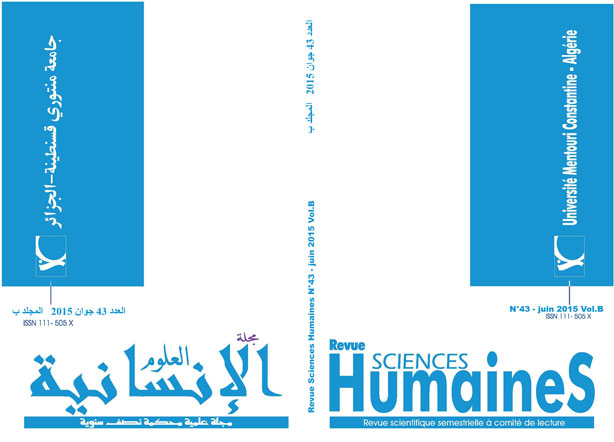Problems in the Implication of the Word Strategy and Its Application in Translating Poetry: A Contrastive Linguistic Study
الكلمات المفتاحية:
Word Strategy، Translating Poetryالملخص
There is some disagreement about translation strategies in general and the strategies used in translating poetry in particular amongst translation scholars not only in the terminology but also in the concept since different labels such as technique, procedure, method, and strategy are utilized. These terms can generally overlap which confuses some concepts with the others. In this respect, this study focuses on translation strategies which are the ways that a translator may follow when finding exact equivalents is almost impossible. These strategies swing between domesticating the source text to the norms that govern the target text and foreignizing the target text to the rules that manage the source text. Thus, distinguishing between main and secondary ideas, establishing conceptual relationships, searching for information, paraphrasing, back translating, translating out loud, establishing an order for documentation, etc. help the translator find a solution in order to mediate between the source text and the target text. For that, since there is no unified model about the strategies used in translating poetry; we shall try to find a solution through analyzing five poems of Robert Frost using the method of analyzing literary texts.
التنزيلات
المراجع
(1) Hervey, S. & Higgins, I. (2002). Thinking French Translation: A Course in Translation Method French into English (2nd Ed.). Routledge. London & New York. pp.33-47.
(2) Ghazala, H. (1995). Translation as problems and solutions: a Cousebook for University Students and Trainee Translators. Malta: ELGA Publication.
(3) Newmark, P. (1988). A Textbook of Translation. Hemel Hempstead: Prentice-Hall Europe. p. 51.
(4) Vinay, J. P. & Darbelnet, J. (1995). Comparative Stylistics of French and English: A Methodology for Translation. Amsterdam and Philadelphia: Benjamins. pp. 30-42/338.
(5) Molina, L. & Albir, H. META Journal des Traducteur (Translator’s Journal)volume.47 n=4, Décembre 2002. Translation Techniques Revisited: A Dynamic and Functionalist Approach. Montréal : Les Presse de L’Université
(6) House, J. & Blum-Kulka, S. (1986). Interlingual and Intercultural Communication: Discourse and Cognition in Translation and Second Language Acquisition Studies. Gunter Narr Verlag Tubingen. Kring, H. P. University of Bochum: Translation Problems and Translation Strategies of Advanced German learnersof French (L2). Pp. 507-268
(7) Bastin, G. L., « La notion d'adaptation en traduction », in Meta, XXXVIII, 3, 1993, pp. 473-478.
(8) Brisset, A. (1989) ‘In Search of a Target Language’, Target 1(1): 10–27.
(9) Santoyo, J. C. (1984). ‘La traducción como técnica narrativa’, Actas del IV Congreso de la Asociación Española de Estudios Anglo Norteamericanos , Salamanca: Ediciones Universidad de Salamanca, 37–53
(10) Baker, M. (ed.) (2001). Routledge Encyclopaedia of Translation Studies London: Routledge.
(11) Synge, J. M. (2008). The Aran Islands. USA: NuVision Publications.
(12) Holmes, J. S. :”Forms of Verse Translation and Translation of Verse Forms”, In Holmes (ed.). The Nature of Translation. Publishing House of the Slovak Academy of science Bratislava 1968 & Mouton. Paris, 1970. Pp.91-105..
(13) Khallussi, S. (1982). The Art of Translation (Fan Ttarjamah Fi Dhaw’e Eddirasset Lmukarenah). Bagdad: Dar Errashid Lilnashr.
(14) Aziz, Y. et. al. (1972). Ettarjamah Al’ilmiya Wa Ttikaniya Wa Ssohofiya Wa L’adabiya: from English to Arabic. Mawsil: Alexandria Library
(15) Connolly, D. (1998). ‘Poetry Translation’, in Mona Baker (ed.) Routledge Encyclopedia of Translation Studies (1st edition), London & New York: Routledge, 170–6.
(16) Ba-Jubair, N. (2011). The Second International Conference on Translation. Translatability of Classical Arabic Poetry into English: Al-Baraduni’s from Balquees Land, An Example. (JICOT 2). p. 39. Amman: Petra University.
(17) Hunston, S. (2000). Corpora in Applied Linguistics. Cambridge University Press. Cambridge.
(18) Abu Moindjie, M. (2006). A Comparative Study of Literary Translation from Arabic into English and French (PhD). Universiti Sains Malaysia.Malaysia.
(19) Frost, R. (1995). Collected Poems and Essays. NY: The Library of America.
Bibliography
Baker, M. (1992):In Other Words.A Coursebook in Tanslation, Routledge: London andNew York.
Breuer, I.,Napthine, M. and Oshea, R. (2008):Persuasive Language in Media Texts, InsightPublications: Australia.
Brown,G. and Yule,G. (1983) : Discourse Analysis, Cambridge University Press .
Cook, G.(1992):The Discourse of Advertising, Routledge: London.
Cui, Y. and Zhao, Y. (2013): ‘‘The Application of Repetition in Advertisement Translation: Its Role in Enhancing Audiences’ Memorization’’, International Journal of Applied LinguisticStudie,volume 2 issue 2 pp.29-37.
Halliday, M.and Hasan, (1976):Cohesion in English, Longman: London and New York.
Kuran, T. (1997): Private Truths,Public Lies: the Social Consequences of Preference Falsification, Library of Congress: USA.
Mc Carthy, M. (1991): Discourse Analysis, Cambridge University Press.
Schiffrin, D., Annen, H. and Hamilton, H.(eds) The Handbook of Discourse Analysis2001 Blackwell Publishing: Massachusetts.
Sternkopf S. (2005): English in Marketing: International Communication Strategies inSmall and Medium Size Enterprises, Verlag Fur Wissenschafluche.












